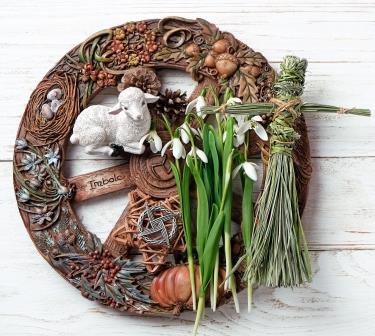
Refresh, review and renew!
Aligned with re-birth and the onset of Spring, Imbolc is celebrated on February 1st at the halfway point between the calm resting-point of Winter Solstice and Spring Equinox’s exuberant energy. It is one of the four seasonal cross-quarter festivals and although mentioned in early Irish texts it seems likely that the origins of Imbolc may be found in pagan celebrations at the start of lambing and the worshipping of the pagan goddess Brigid. Burning lamps and lighting bonfires, and crafting effigies of the pagan goddess from bundles of rushes or oat straws prepared for inviting Brigid into the home. It was hoped she would bring fertility as people began sowing seeds for crops and watched the new generations of sheep and cattle come into the world.
In the Mother’s Belly
Imbolc translates as “in the mother’s belly”. You may observe new life appearing in the form of Spring bulbs popping up, buds on the trees and catkins ‘lamb’s tails’ on the hazel bushes. In some parts of the country, there will be young lambs in the fields, and days noticeably lengthen, offering new beginnings on the horizon.
Over the centuries, and with the coming of Christianity, Brigid was adopted as Saint Brigid (or Bridget), and is one of Ireland’s three patron saints. The Catholic Church claims that she was an historical person, and her life was written about by monks in the 8th century. She is said to have had no interest in being married and founded a monastery in Kildare where she lived out her life, healing and giving charity to the poor. Legend says that after St Brigid died in 524AD the nuns of Kildare built a fire in her honour which burned for 500 years but produced no ash; only women were ever allowed to be near this fire.
Fire & Milk
Saint Brigid is associated with milk and fire and was celebrated for her extensive agricultural knowledge. Thus, it is easy to see the similarity with the old pagan goddess Brigid.
The celebration of St Brigid’s day on February 1st was put into place to replace Imbolc by the Church. Instead of creating effigies of the pagan goddess, the custom grew of fashioning ‘Brigid crosses’. Traditionally, hung over doors, windows and in stables to welcome the Saint and protect against illness, fire, lightning and evil spirits, these were often left in place until next St Brigid’s day.
Wheel of the Year Energies
If you enjoy working with the energies of the Wheel of the Year, now is a fantastic time to look at re-connecting with nature, reflecting on what has passed and looking forward to what you want to bring to fruition in your life as the season for new growth dawns. Traditionally it’s a time for a good old spring cleaning of our homes, literally sweeping away the debris of the dark months and opening the windows wide to welcome fresh air, light and new hope.
The seeds of your intentions that have been lying dormant are about to come to life!
Written by Vanessa, PIN: 3900
Posted: 30/01/2024
Related Category: Spiritual Holidays












